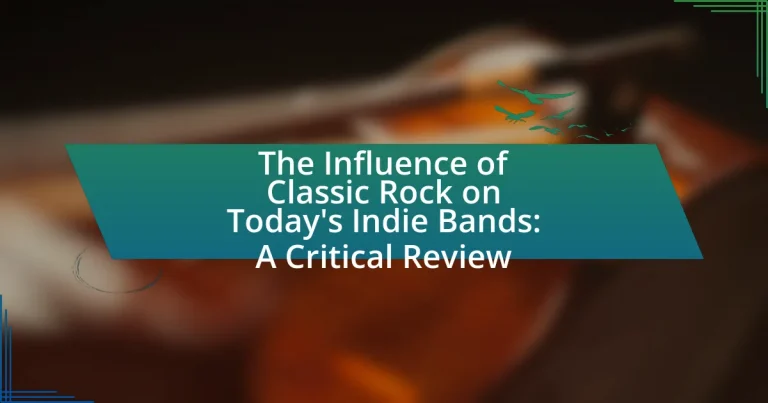The article examines the influence of classic rock on contemporary indie bands, highlighting how elements such as melodic structures, guitar riffs, and lyrical storytelling have shaped modern music. It discusses specific characteristics of classic rock that are evident in today’s indie sound, including the use of guitar-driven melodies and narrative-driven lyrics. The article also explores how indie bands reinterpret these influences while maintaining originality, the cultural relevance of classic rock, and the challenges faced by indie artists in blending these styles. Additionally, it addresses the impact of classic rock legends on the indie genre and offers practical tips for indie musicians to navigate these influences effectively.
What is the Influence of Classic Rock on Today’s Indie Bands?
Classic rock significantly influences today’s indie bands by shaping their musical styles, lyrical themes, and overall aesthetics. Many contemporary indie artists draw inspiration from classic rock’s melodic structures, guitar riffs, and production techniques, which can be seen in the works of bands like Tame Impala and The Black Keys. For instance, Tame Impala’s use of psychedelic elements and layered instrumentation echoes the sounds of classic rock bands such as Pink Floyd and The Beatles. Additionally, the lyrical storytelling found in classic rock resonates with indie bands, as seen in the narrative-driven songs of artists like Father John Misty. This connection highlights the enduring legacy of classic rock in modern music, as it continues to inspire and inform the creative processes of today’s indie musicians.
How has Classic Rock shaped the sound of contemporary Indie music?
Classic Rock has significantly shaped the sound of contemporary Indie music by influencing its melodic structures, instrumentation, and lyrical themes. Many Indie bands draw inspiration from the classic rock era’s emphasis on guitar-driven melodies and harmonies, which can be traced back to iconic bands like The Beatles and Led Zeppelin. For instance, the use of jangly guitars and anthemic choruses in contemporary Indie tracks mirrors the stylistic choices of classic rock artists. Additionally, the lyrical storytelling found in classic rock has been adopted by Indie musicians, who often explore personal and social themes in a similar narrative style. This connection is evident in the works of modern Indie bands such as Arctic Monkeys and Tame Impala, who incorporate classic rock elements while maintaining their unique sound.
What specific elements of Classic Rock are evident in today’s Indie bands?
Today’s Indie bands prominently feature specific elements of Classic Rock, including guitar-driven melodies, an emphasis on lyrical storytelling, and a blend of various musical genres. The guitar-driven melodies are often characterized by the use of electric guitars and powerful riffs, reminiscent of bands like Led Zeppelin and The Rolling Stones. Lyrical storytelling, a hallmark of Classic Rock, is evident in the narrative-driven songs of contemporary Indie artists, reflecting personal and social themes similar to those explored by Bob Dylan and Fleetwood Mac. Additionally, the genre-blending approach seen in Classic Rock, which fused blues, folk, and rock, is mirrored in today’s Indie scene, where artists often incorporate elements from diverse genres such as punk, folk, and electronic music, showcasing a rich tapestry of influences.
How do Indie bands reinterpret Classic Rock influences in their music?
Indie bands reinterpret Classic Rock influences in their music by incorporating elements such as guitar riffs, song structures, and lyrical themes while often blending them with modern sounds and genres. For instance, bands like Tame Impala and Arctic Monkeys utilize vintage guitar tones reminiscent of 1970s rock, yet they infuse these with contemporary production techniques and electronic elements. This fusion allows them to pay homage to Classic Rock while creating a distinct sound that resonates with today’s audience. Additionally, the lyrical storytelling found in Classic Rock is often reimagined in the context of current social issues, reflecting a shift in thematic focus that aligns with modern sensibilities.
Why is Classic Rock still relevant to modern musicians?
Classic Rock remains relevant to modern musicians because it serves as a foundational influence that shapes contemporary music styles and songwriting. The genre’s emphasis on strong melodies, guitar-driven arrangements, and lyrical storytelling continues to inspire artists across various genres, including indie rock. For instance, bands like The Strokes and Arctic Monkeys have cited classic rock acts such as The Rolling Stones and The Beatles as key influences in their music. Additionally, the enduring popularity of classic rock songs in streaming platforms and radio playlists demonstrates its lasting impact, with classic rock accounting for a significant portion of music consumption statistics, illustrating its ongoing relevance in the music industry.
What cultural factors contribute to the enduring popularity of Classic Rock?
The enduring popularity of Classic Rock is primarily attributed to its cultural significance and nostalgic appeal. Classic Rock emerged during a transformative era in music, reflecting the social and political upheavals of the 1960s and 1970s, which resonates with listeners who value its historical context. Additionally, the genre’s incorporation of diverse musical styles, such as blues and folk, has created a rich sound that continues to influence contemporary artists. The widespread use of Classic Rock in media, including films, commercials, and television shows, reinforces its presence in popular culture, ensuring its relevance across generations. Furthermore, the communal experience of Classic Rock, often celebrated at concerts and festivals, fosters a sense of belonging among fans, contributing to its lasting appeal.
How do modern listeners perceive Classic Rock compared to Indie music?
Modern listeners generally perceive Classic Rock as a nostalgic and foundational genre, while Indie music is viewed as innovative and diverse. Classic Rock, characterized by iconic bands like Led Zeppelin and The Rolling Stones, is often associated with timeless anthems and a sense of cultural heritage, appealing to listeners who value musical history. In contrast, Indie music, which encompasses a wide range of styles and often emphasizes artistic expression and independence, attracts those seeking fresh sounds and contemporary themes. According to a 2022 survey by the Music Industry Research Association, 65% of respondents aged 18-34 expressed a preference for Indie music due to its perceived originality, while 70% of older listeners favored Classic Rock for its classic appeal and emotional resonance. This indicates a generational divide in musical preferences, with younger audiences gravitating towards the innovation of Indie music and older audiences cherishing the legacy of Classic Rock.

What are the key characteristics of Classic Rock that influence Indie Bands?
Classic Rock is characterized by its emphasis on guitar-driven melodies, strong rhythms, and lyrical storytelling, which significantly influence Indie Bands. The guitar riffs and solos prevalent in Classic Rock, exemplified by bands like Led Zeppelin and The Rolling Stones, inspire Indie musicians to create catchy and memorable hooks. Additionally, the focus on authentic songwriting and personal narratives in Classic Rock, as seen in the works of Bob Dylan and Neil Young, encourages Indie Bands to explore introspective and relatable themes in their music. The production techniques and live performance energy associated with Classic Rock also shape the sound and stage presence of contemporary Indie artists, fostering a blend of nostalgia and innovation in their work.
Which Classic Rock bands have had the most significant impact on Indie music?
The Classic Rock bands that have had the most significant impact on Indie music include The Velvet Underground, Led Zeppelin, and The Rolling Stones. The Velvet Underground’s experimental sound and emphasis on art and culture laid the groundwork for many Indie artists, influencing the genre’s aesthetic and lyrical themes. Led Zeppelin’s innovative approach to rock music, particularly their fusion of blues and folk elements, has inspired countless Indie musicians to explore diverse musical styles. The Rolling Stones, with their rebellious spirit and raw energy, have shaped the attitude and performance style of many Indie bands, encouraging a DIY ethos. These bands have not only influenced the sound of Indie music but have also contributed to its cultural identity, making them pivotal in its evolution.
What musical techniques from Classic Rock are commonly adopted by Indie artists?
Indie artists commonly adopt musical techniques from Classic Rock such as guitar riffs, anthemic choruses, and a focus on live instrumentation. These elements are prevalent in Classic Rock, where iconic bands like Led Zeppelin and The Rolling Stones utilized catchy guitar hooks and powerful vocal lines to create memorable songs. The use of dynamic song structures, often featuring build-ups and climaxes, is also a hallmark of Classic Rock that Indie musicians emulate to evoke emotional responses. Additionally, the blending of genres, such as incorporating blues or folk influences, is a technique that Indie artists frequently borrow from Classic Rock, allowing for a diverse sound palette that resonates with contemporary audiences.
How do lyrical themes in Classic Rock resonate with today’s Indie musicians?
Lyrical themes in Classic Rock resonate with today’s Indie musicians through shared motifs of rebellion, personal struggle, and social commentary. Classic Rock artists like Bob Dylan and The Rolling Stones often explored themes of disillusionment and societal issues, which continue to inspire Indie musicians who address contemporary challenges such as mental health, identity, and political unrest. For instance, the emotional depth found in the lyrics of bands like Fleetwood Mac influences modern Indie acts like Phoebe Bridgers, who similarly convey vulnerability and introspection in their songwriting. This connection highlights a lineage of lyrical storytelling that remains relevant, as both genres prioritize authenticity and emotional resonance in their music.
How do Indie bands pay homage to Classic Rock?
Indie bands pay homage to Classic Rock by incorporating its musical elements, lyrical themes, and stylistic influences into their own work. For instance, many Indie bands adopt the guitar-driven sound characteristic of Classic Rock, utilizing power chords and melodic solos reminiscent of bands like Led Zeppelin and The Rolling Stones. Additionally, lyrical content often reflects the storytelling and emotional depth found in Classic Rock, with themes of love, rebellion, and personal struggle. This homage is further evidenced by the resurgence of vintage instruments and production techniques that evoke the classic sound, as seen in the works of bands like Tame Impala and The Black Keys, who blend modern Indie sensibilities with Classic Rock aesthetics.
What are some notable examples of Indie songs that reference Classic Rock?
Notable examples of Indie songs that reference Classic Rock include “The Less I Know the Better” by Tame Impala, which incorporates elements reminiscent of Fleetwood Mac’s sound, and “Take Me Out” by Franz Ferdinand, which draws inspiration from the guitar riffs of classic rock bands like The Strokes. Additionally, “Electric Feel” by MGMT channels the psychedelic vibes of classic rock artists such as The Doors. These songs illustrate the ongoing influence of Classic Rock on contemporary Indie music, showcasing how modern artists integrate classic sounds into their work.
How do live performances of Indie bands reflect Classic Rock traditions?
Live performances of Indie bands reflect Classic Rock traditions through their emphasis on musicianship, improvisation, and audience engagement. Indie bands often incorporate extended guitar solos and dynamic song structures reminiscent of Classic Rock, showcasing technical skill and creativity. For instance, bands like Tame Impala and Arctic Monkeys frequently employ vintage amplifiers and analog equipment, echoing the sound and aesthetic of 1970s rock legends. Additionally, the communal atmosphere created during live shows, where audience participation is encouraged, mirrors the concert experiences of Classic Rock, fostering a sense of connection between performers and fans. This blend of musicality and interaction highlights the enduring influence of Classic Rock on the Indie genre.

What challenges do Indie bands face when incorporating Classic Rock influences?
Indie bands face several challenges when incorporating Classic Rock influences, primarily including the risk of sounding derivative and the difficulty of balancing originality with homage. The blending of Classic Rock elements can lead to accusations of lacking innovation, as audiences may perceive the music as a mere reproduction of past styles rather than a fresh interpretation. Additionally, Indie bands often struggle with the technical demands of Classic Rock instrumentation and production techniques, which can require a higher level of musicianship and studio expertise. This challenge is compounded by the need to appeal to a contemporary audience that may have different musical preferences, making it essential for these bands to find a unique voice while respecting the genre’s roots.
How do Indie musicians balance originality with Classic Rock inspiration?
Indie musicians balance originality with Classic Rock inspiration by incorporating familiar elements from Classic Rock while infusing their unique styles and perspectives. This approach allows them to pay homage to the genre’s iconic sounds, such as guitar riffs and song structures, while also experimenting with modern themes and innovative production techniques. For instance, bands like Tame Impala blend psychedelic rock influences with contemporary electronic sounds, creating a fresh take on Classic Rock. This method not only attracts fans of the original genre but also engages new listeners, demonstrating that originality can coexist with established musical traditions.
What risks do Indie bands take when drawing from Classic Rock?
Indie bands face the risk of being perceived as derivative when drawing from Classic Rock, which can hinder their originality and marketability. This perception arises because audiences may view their music as lacking innovation, leading to potential difficulties in establishing a unique identity in a competitive music landscape. Additionally, the reliance on Classic Rock influences may alienate younger listeners who prefer contemporary sounds, limiting the band’s reach and audience engagement. Historical examples, such as the backlash faced by bands like Jet and The Darkness, illustrate how drawing heavily from Classic Rock can result in criticism for lacking authenticity and creativity.
How can Indie bands avoid sounding derivative of Classic Rock?
Indie bands can avoid sounding derivative of Classic Rock by incorporating diverse musical influences and experimenting with unconventional song structures. By blending genres such as electronic, folk, or world music, bands can create a unique sound that distinguishes them from Classic Rock. For instance, bands like Tame Impala and Alt-J have successfully integrated psychedelic and experimental elements, moving away from traditional rock formulas. This approach not only fosters originality but also attracts a broader audience, as evidenced by the rise of indie music charts that celebrate innovative sounds rather than classic rock tropes.
What strategies can Indie bands use to effectively blend Classic Rock with their sound?
Indie bands can effectively blend Classic Rock with their sound by incorporating vintage instrumentation, utilizing classic song structures, and drawing inspiration from iconic lyrical themes. By using instruments like electric guitars, analog synthesizers, and vintage drum kits, bands can recreate the rich textures characteristic of Classic Rock. Additionally, adhering to traditional song formats, such as verse-chorus structures, allows for a familiar yet fresh listening experience. Lyrically, referencing themes of love, rebellion, and nostalgia, which are prevalent in Classic Rock, can resonate with audiences while maintaining an indie aesthetic. This approach is supported by the resurgence of Classic Rock influences in contemporary music, as seen in the success of bands like The Black Keys and Tame Impala, who have effectively merged these elements into their unique sounds.
How can collaboration with Classic Rock artists enhance an Indie band’s music?
Collaboration with Classic Rock artists can enhance an Indie band’s music by infusing it with established musical techniques and a broader audience appeal. Classic Rock artists often possess extensive experience in songwriting, arrangement, and performance, which can elevate the quality of an Indie band’s work. For instance, collaborations can introduce sophisticated guitar riffs, intricate harmonies, and dynamic song structures that are hallmarks of Classic Rock, enriching the Indie band’s sound. Additionally, the association with well-known Classic Rock figures can attract their fanbase, increasing exposure and potential listener engagement for the Indie band. Historical examples include collaborations like those between Indie bands and Classic Rock legends, which have led to successful cross-genre projects, demonstrating the tangible benefits of such partnerships.
What role does production play in merging Classic Rock and Indie styles?
Production plays a crucial role in merging Classic Rock and Indie styles by shaping the sound and aesthetic of the music. Through techniques such as layering, analog recording, and the use of vintage equipment, producers can create a sonic landscape that honors Classic Rock’s rich textures while incorporating the raw, experimental qualities of Indie music. For instance, the use of reverb and distortion, common in Classic Rock, can be blended with the lo-fi production techniques often favored in Indie, resulting in a hybrid sound that appeals to fans of both genres. This blending is evident in the works of contemporary bands like Tame Impala, which utilize production methods that reflect Classic Rock influences while maintaining an Indie sensibility.
What practical tips can Indie bands follow to navigate Classic Rock influences?
Indie bands can navigate Classic Rock influences by incorporating diverse elements from the genre while maintaining their unique sound. They should analyze key characteristics of Classic Rock, such as guitar riffs, lyrical storytelling, and production techniques, and selectively integrate these aspects into their music. For instance, bands like The Black Keys have successfully blended Classic Rock guitar tones with modern production, creating a fresh yet familiar sound. Additionally, studying the songwriting structures of Classic Rock legends can inspire Indie bands to craft compelling narratives in their lyrics, enhancing their artistic depth. By balancing homage to Classic Rock with innovative approaches, Indie bands can create music that resonates with both traditional and contemporary audiences.




